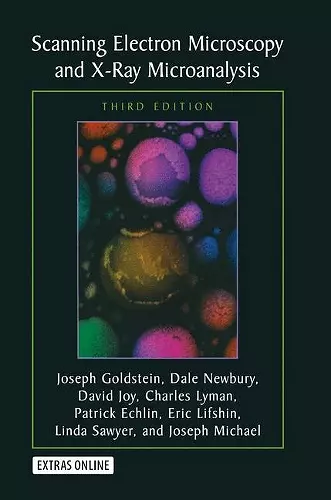Scanning Electron Microscopy and X-Ray Microanalysis
Third Edition
Joseph Goldstein author Patrick Echlin author David C Joy author Dale E Newbury author Charles E Lyman author Eric Lifshin author Linda Sawyer author JR Michael author
Format:Hardback
Publisher:Springer Science+Business Media
Published:31st Jan '03
Should be back in stock very soon

In the decade since the publication of the second edition of Scanning Electron Microscopy and X-Ray Microanalysis, there has been a great expansion in the capabilities of the basic scanning electron microscope (SEM) and the x-ray spectrometers. The emergence of the variab- pressure/environmental SEM has enabled the observation of samples c- taining water or other liquids or vapor and has allowed for an entirely new class of dynamic experiments, that of direct observation of che- cal reactions in situ. Critical advances in electron detector technology and computer-aided analysis have enabled structural (crystallographic) analysis of specimens at the micrometer scale through electron backscatter diffr- tion (EBSD). Low-voltage operation below 5 kV has improved x-ray spatial resolution by more than an order of magnitude and provided an effective route to minimizing sample charging. High-resolution imaging has cont- ued to develop with a more thorough understanding of how secondary el- trons are generated. The ?eld emission gun SEM, with its high brightness, advanced electron optics, which minimizes lens aberrations to yield an - fective nanometer-scale beam, and “through-the-lens” detector to enhance the measurement of primary-beam-excited secondary electrons, has made high-resolution imaging the rule rather than the exception. Methods of x-ray analysis have evolved allowing for better measurement of specimens with complex morphology: multiple thin layers of different compositions, and rough specimens and particles. Digital mapping has transformed classic x-ray area scanning, a purely qualitative technique, into fully quantitative compositional mapping.
“There is no other single volume that covers as much theory and practice of SEM or X-ray microanalysis as Scanning Electron Microscopy and X-ray Microanalysis, 3rd Edition does. It is clearly written ... well organized. ... This is a reference text that no SEM or EPMA laboratory should be without.” (Thomas J. Wilson, Scanning, Vol. 27 (4), July/August, 2005)
“As the authors pointed out, the number of equations in the book is kept to a minimum, and important conceptions are also explained in a qualitative manner. A lot of very distinct images and schematic drawings make for a very interesting book and help readers who study scanning electron microscopy and X-ray microanalysis. The principal application and sample preparation given in this book are suitable for undergraduate students and technicians learning SEEM and EDS/WDS analyses. It is an excellent textbook for graduate students, and an outstanding reference for engineers, physical, and biological scientists.” (Microscopy and Microanalysis, Vol. 9 (5), October, 2003)
ISBN: 9780306472923
Dimensions: unknown
Weight: unknown
689 pages
3rd ed. 2003